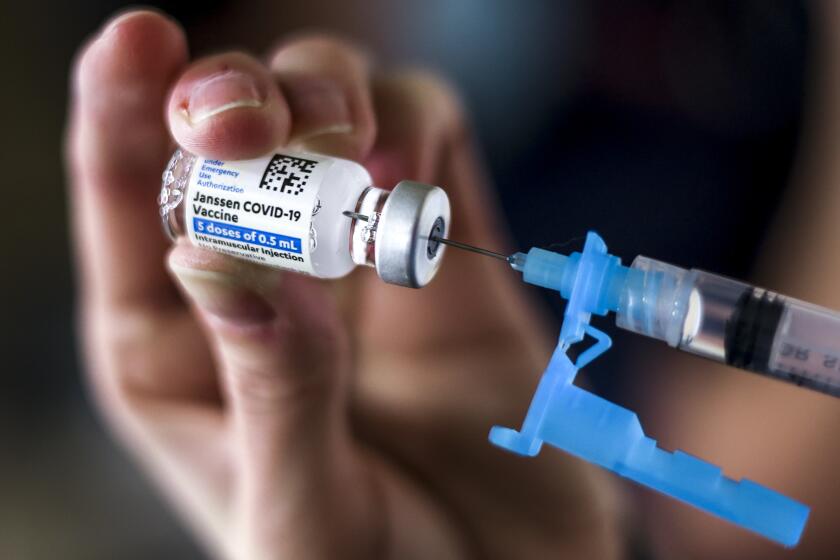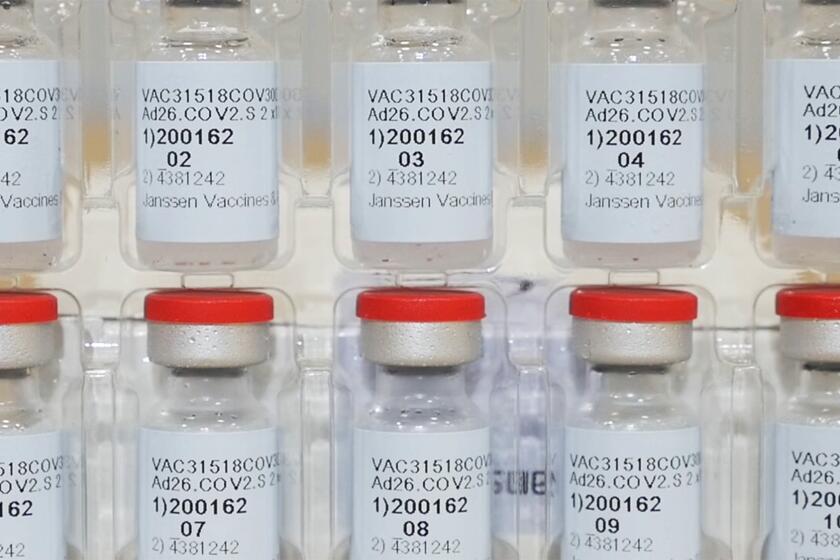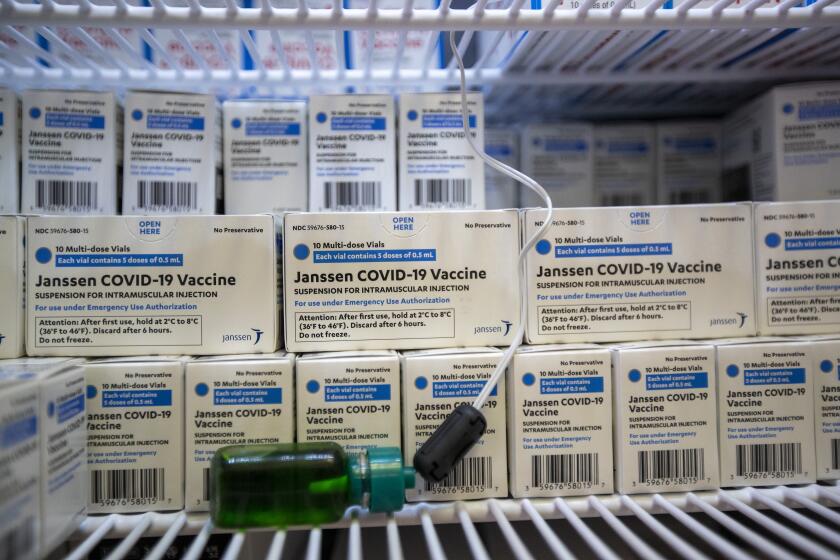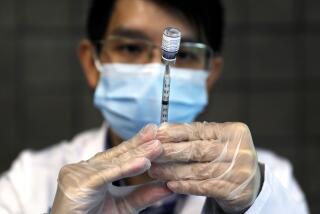U.S. lifts pause on J&J vaccinations, clearing the way for shots to resume
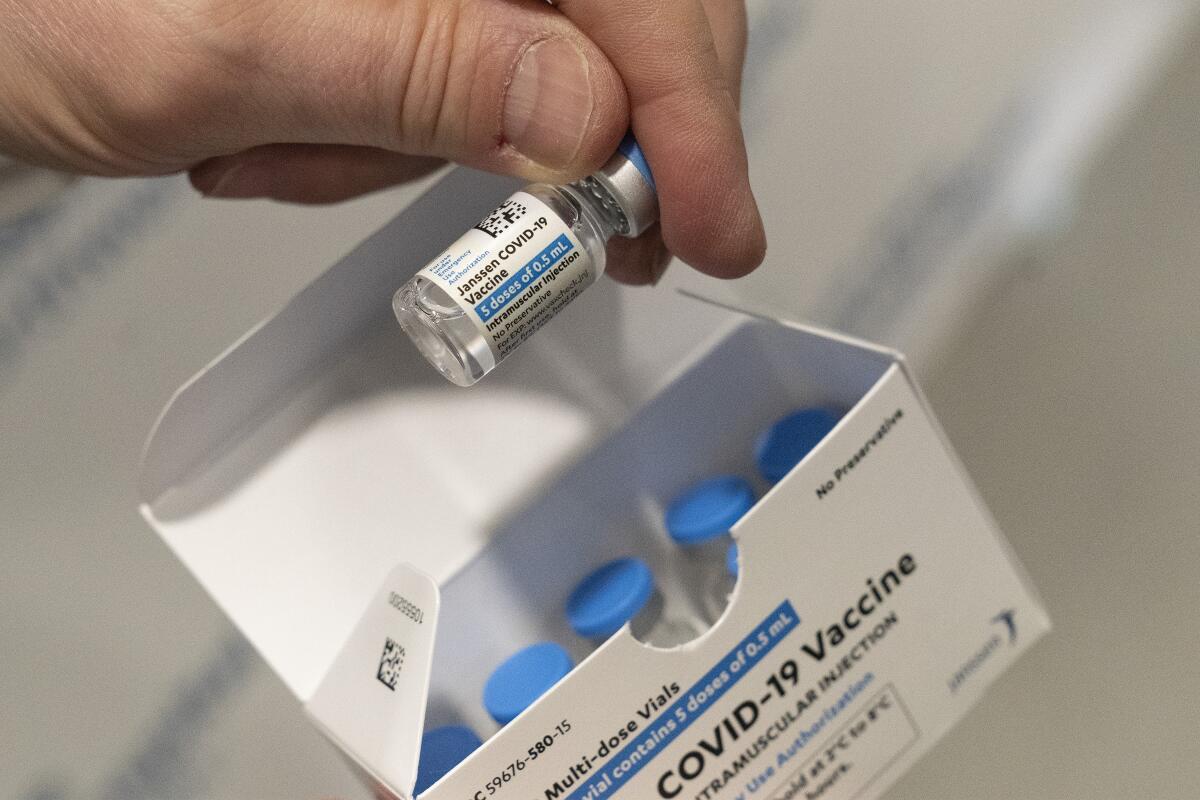
- Share via
Johnson & Johnson’s COVID-19 vaccine will be back in circulation this weekend after the U.S. Centers for Disease Control and Prevention accepted an advisory panel’s decision that the disease-fighting benefits of the shots outweighed the risks.
The CDC’s action lifted a 10-day pause that went into effect April 13 after federal safety monitors received reports of a rare but potentially deadly blood clotting disorder in people who received the J&J vaccine.
The restart means the single-dose shots will return to mass vaccination drives, pharmacies and doctors’ offices immediately. They will come with newly drafted fact sheets that detail the disorder that has been detected in 15 patients since the J&J vaccine rolled out on March 2.
In Los Angeles County, health officials said they expect to resume distribution of the J&J vaccine on Saturday.
“We are prepared to resume very quickly,” said Dr. Paul Simon, chief science officer for the L.A. County Department of Public Health. “We are in the process of developing or finalizing education materials for clients and also providers so we can move forward in the safest way.”
The pause does not appear to have limited vaccine access in L.A. County, since supplies of the Pfizer-BioNTech and Moderna vaccines remained high and demand for the shots has slowed, he added.
Dr. Rochelle Walensky, the CDC director, said the country would benefit by having the Johnson & Johnson offering available alongside the two-dose vaccines made by Pfizer-BioNTech and Moderna.
“The Johnson & Johnson is an important vaccine offering key advantages,” Walensky said. Key among them: It doesn’t require special refrigeration and it provides full protection in a single jab.
State and local health authorities are keen to use the vaccine in populations that are hard to reach or who may not return for a second dose. A longer pause was likely to impede the vaccination of homebound individuals, prisoners, homeless people and seasonal and migrant workers, the CDC said.
A CDC advisory panel is grappling with the best way to “do no harm” regarding Johnson & Johnson’s COVID-19 vaccine and its risk of blood clots.
Roughly 9 million doses of the vaccine are already distributed to sites across the country, and almost 4 million more are available for immediate order.
After early detection of a problem prompted an abrupt pause and exhaustive review of the vaccine’s risks and benefits, “the American public should feel reassured,” Walensky said.
The CDC’s Advisory Committee on Immunization Practices learned Friday that the blood disorder known as thrombotic thrombocytopenia syndrome, or TTS, had been detected in a total of 15 U.S. patients who received the vaccine. All were women, and virtually all were under the age of 50. Three have died, and seven remain in the hospital, including four who remain in intensive care.
With nearly 8 million doses of the vaccine already administered, however, that is an extremely rare outcome, the CDC told panel members at their Friday meeting.
In the general population, fewer than 2 in a million people getting the J&J shot could be expected to develop the perplexing clotting disorder. Among women between the ages of 18 and 50 — the group in which the complication was seen most frequently — the rate would be 7 per million.
In that same universe of women, however, those 1 million doses could prevent 12 deaths from COVID-19, along with 650 hospitalizations, the CDC calculated.
Two COVID-19 vaccines have now been linked to a risk of developing blood clots. Scientists don’t know whether the vaccines are to blame.
In the general U.S. adult population, the vaccine’s return to use could give rise to 26 cases of TTS over the next six months while preventing between 600 and 1,400 COVID-19 deaths and reducing the number of patients needing intensive hospital care by 800 to 3,500, the CDC estimated.
Federal health officials said that with growing awareness and more appropriate treatment of the rare side effect, the balance of benefits and risks will tip further toward the J&J vaccine’s broader use.
With that information in mind, the panel voted 10 to 4 to bring the vaccine back.
Dr. Peter Marks, the FDA’s chief of drug evaluation, said Friday that fact sheets outlining the signs, symptoms and proper treatment of TTS had already gone out to the medical community and to state and local health officials.
In the coming weeks, he added, “there’ll be a lot of scientific work” to understand what factors might prompt a potential vaccine recipient to develop TTS in response to a vaccine that ferries its immune payload into the body on the back of a harmless cold virus.
That will be crucial, since a vaccine of similar design, made by AstraZeneca, is expected to be considered soon for emergency use authorization in the United States. That vaccine also has been linked to unusual clotting disorders in the United Kingdom and Europe.
The ramifications of Friday’s decision will extend beyond U.S. borders, Walensky said: It will greenlight its use in many low- and middle-income countries around the world that were depending on it.
“Many have wanted the J&J vaccine to fill an important need here and around the world,” she said.
Experts said that while the pause on Johnson & Johnson’s vaccine may make sense for the U.S., stoppages in poorer countries would end up costing lives.
When the FDA and CDC first called for the pause, public health leaders worried it might wind up costing more lives than it saved, especially in poorer countries where skepticism about the vaccines runs high and other immunization options are limited.
“This is going to assist in restoring confidence in the vaccine. There isn’t any doubt about that,” said Dr. William Schaffner, an infectious disease expert at Vanderbilt University.
Around the world, he said, “ministries of health are going to take notice of this action.”
In the U.S., surveys conducted by the CDC have found particular enthusiasm among Latinos for a single-shot vaccine.
The pause is likely to have heightened skepticism that the J&J offering is an inferior product being foisted on Black Americans, said Dr. Georges Benjamin, executive director of the American Public Health Assn.
“We have to work very hard to correct the record on that,” Benjamin said. “We’ve got to be frank about that: This is not an inferior product. This one-shot vaccine is different. But it’s not inferior.”
The COVID-19 vaccine from Johnson & Johnson will save lives. But public health officials must address the false narrative that it’s a lesser vaccine.
Epidemiologist Theresa Chapple agreed. In communities of color and low-income countries across the globe, the U.S. pause caused confidence to waver.
“I believe that with time, confidence will be restored,” Chapple said. The evidence laid before the panel made clear that “for those who may be at increased risk, the benefits far outweigh the risk.”
The scientific findings of federal health agencies came under the panel’s scrutiny in six hours of debate and deliberation. Members quickly rejected recommending limits on the use of the J&J vaccine based on age or sex. And in the end, it declined to adopt language that would have underscored concerns about TTS in adult women younger than 50.
In comments echoed by many, Stanford University pediatrician Dr. Grace Lee rejected a proposal that women be made “aware” of the vaccine’s link to such rare blood clots. The fine print of the FDA’s emergency use authorization already does that, she said.
Other language suggesting that women “may choose” another COVID-19 vaccine would be unnecessary and potentially confusing, Lee added.
Besides, adding such language to its recommendation to resume J&J vaccine administration could “introduce logistics issues,” warned Dr. Nirav Shah, another panel member. Vaccination managers might interpret such language as requiring a formal process of informed consent on the part of potential vaccine recipients, or it might be seen as requiring that women be given immediate access to a Moderna or Pfizer vaccine alongside J&J’s.
“It might slow things down,” said Shah, who is Maine’s chief of public health.
Asked Friday whether younger women should get the Johnson & Johnson vaccine, Walensky said that was a decision only potential recipients could make. What’s important, she said, is that they be given not only a choice of vaccines, but the tools they need to decide which one works best for them.
“Some people want a one-and-done. People have to individually measure for themselves,” she said. “This should be certainly an option for women in that age category. It’s safe and available for their use.”
Los Angeles County is ready to again administer the Johnson & Johnson COVID-19 vaccine after federal health agencies on Friday lifted the pause that’s kept those doses in limbo for more than a week.
Still unknown is whether the public will have cooled to the Johnson & Johnson vaccine despite the CDC panel’s insistence that it’s safe for shots to resume.
“It’s still not entirely clear how much of a setback this has been,” Simon said. “We don’t want to see vaccine shopping. We really want to see people get the first vaccine available to them.”
Corey Matthews, the chief operating officer of Community Coalition, a South Los Angeles organization that helped set up and run vaccine sites, said some of the people his group served had lingering hesitation about the Johnson & Johnson vaccine even before the pause. They had viewed it as a second-class shot because it didn’t seem to perform as well in clinical trials as the Pfizer and Moderna vaccines — and publicity about the rare blood clotting disorder didn’t help.
“We certainly suffered a little bit of a blow to the momentum we had of getting people vaccinated quickly, especially people who weren’t originally comfortable with it,” Matthews said.
But the J&J vaccine did have its admirers, especially those who appreciated the simplicity of its single dose.
“Some folks just don’t like needles,” he said. “I’m thankful we quickly got it reinstated.”
Times staff writers Colleen Shalby, Emily Baumgaertner and Deborah Netburn contributed to this report.
